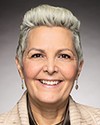Madam Speaker, thank you for giving me a moment. I practised my speech, but it does not get easier. I am sure it does not get easier for anyone.
Captain Dawkins did not know back in 2016 when she was advocating the inclusion of breast cancer that she would be going through it herself only a few years later. During COVID, she was diagnosed with breast cancer, and I am happy to say that she is now back to work after a mastectomy and four months of chemotherapy. She said, “This is an actual result of simply going to work and doing my job.”
Female firefighters are still a rarity in this country. There are very few like Captain Dawkins who have been with the service for 20 years or more, and there is little data about impacts unique to the sexes. San Francisco is further along on data collection. It began hiring women firefighters in the late 1980s. Today, the city has the largest population of female firefighters in the U.S., but unfortunately it also has a high rate of breast cancer among women 40 to 50 years old.
A few years back, it reported that of the 117 female firefighters, 11 had been diagnosed with breast cancer and one had died. That is six times the normal rate. These alarming stats are just another reason this national framework is important. Cancers that affect females need to be included and protected as pre-emptive across the country.
Jenn Dawkins is a constituent in my riding of Port Moody—Coquitlam, and not only did she advocate for the addition of pre-emptive cancer types for firefighters, but she is leading other women into the profession. She started a program called Camp Ignite many years ago. It takes place over four days each summer at different locations in metro Vancouver, hosting girls in grade 11 or 12 who are sponsored by their local departments in their own districts. Each day of the camp is different, with activities like first aid, rope training, aerial work, live fire handling and auto extrication. I think about how this bill could protect those aspiring firefighters.
Protection from illness by raising awareness about the risks of this profession is crucial to help firefighters identify early signs of cancer for testing and treatment. What this bill seeks to do is save lives. It is such important legislation.
Over a firefighter's career, they will go to hundreds of fires, and their risk of cancer increases as they move through their career. Although a firefighter's protective gear is made to withstand 1,000°C, it cannot fully protect from cancer-causing agents because the clothing has to breathe.
That is why the national framework must include measures to do the following: explain the link between firefighting and certain types of cancer; identify the training, education and guidance needs of health care and other professionals related to the prevention and treatment of cancers linked to firefighting; provide for firefighters across Canada to be regularly screened for cancers linked to firefighting; promote research and improved data collection; promote information sharing and knowledge sharing; and establish national standards to recognize cancers linked to firefighting as occupational diseases.
Going back to the experiences of female firefighters in San Francisco, Anita Paratley was a battalion chief for the San Francisco Fire Department. She developed breast cancer in 2003 when she was just 46 years old. She said, “I remember when I raised my hand to swear-in (to the fire service), thinking ‘please be safe, don't get hurt’.... I never thought about cancer.”
In closing, the national framework would provide a number of things, including measures to bring equity to firefighters across the country as it pertains to certain types of cancer for all sexes so that no firefighter in any province is left behind.

